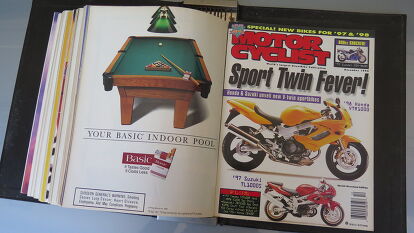"Motorcyclist" Magazine Bites the Dust
Following in the footsteps of Cycle, Sport Rider, Dirt Rider, Hot Bike, Baggers, et al., Bonnier Corporation has decided to kill off the print version of Motorcyclist, though the online version will continue on with the same staff. Bonnier acquired Cycle World first early this decade, then bought Motorcyclist, Sport Rider, Dirt Rider, and one or two more a couple years later, nearly cornering the US motorcycle magazine market as it doubled down on print. The last two years have been an interesting time, as Motorcyclist and CW experimented with having the two big former competitors intermingle their staffs and resources; Cycle World was supposed to be more timely (a tough thing to do given the decision to make it a quarterly publication instead of a monthly), while Motorcyclist was to be a “lifestyle” bimonthly.
Here’s the official release announcing the change:
MOTORCYCLIST TO BECOME A DIGITAL BRAND
May 23rd, 2019, Irvine, CA — Bonnier Corp. will discontinue the printed edition of Motorcyclist after the July/August issue. The brand will continue online at motorcyclistonline.com, and across all social and video platforms.
“Like other enthusiast-content segments, motorcycle readership has evolved to a truly digital audience,” said Andy Leisner, SVP Managing Director of the Bonnier Motorcycle Group. “There have been substantial shifts in consumer content preferences as well as advertisers’ desire to reach motorcycle consumers on these growing digital platforms.”
The digital audience for Motorcyclist has grown substantially, led by the 1.18 million enthusiasts who interact with Motorcyclist’s social channels, including 630,597 Motorcyclist YouTube subscribers. In the past two years, Motorcyclist’s YouTube views have grown by 239 percent, and subscribers have grown by 494 percent. All existing Motorcyclist staff and production resources will be shifted to address the growth on these channels.
Motorcyclist is available on motorcyclistonline.com, all major social platforms, syndication partners such as MSN, and through the successful YouTube series On Two Wheels, MC Garage and MC Commute. Motorcyclist will also continue to be featured in Bonnier Corp.’s motorcycle consumer events.
###
ABOUT BONNIER
Bonnier Corp. is one of the largest special-interest publishing groups in America, with more than 20 multichannel brands extending into all platforms including magazines, digital media, events, and product licensing. Bonnier Corp.’s brands include Popular Science, Saveur, Field & Stream, Yachting, Flying, Salt Water Sportsman, Cycle World, Working Mother, and Outdoor Life. Popular events include the Sand Sports Super Show; Field & Stream/Outdoor Life’s Turkey and Deer Expos; the NOOD Regattas; and the many conferences and seminars of Diversity Best Practices. Bonnier Corp. is owned by Swedish-based Bonnier AB, a multichannel media conglomerate operating in 15 countries.
The good news is nobody seems to be losing their job in this latest move; the bad news is there were only two dedicated Motorcyclist staffers anyway. Editor in Chief Chris Cantle says, “It’s sad to see the print magazine come to an end. So many wonderful editors and contributors worked hard on making it into the institution that it is. Waheed and I [Adam Waheed, the hardest-working man in motojournalism] are the only Bonnier staff dedicated exclusively to the Motorcyclist brand, we’ll focus on keeping the website and YouTube channel growing—so look out!
Just over a year ago, Bonnier had this to say: “We have done extensive research with our audience about their media consumption preferences,” said Bonnier Motorcycle Group SVP/Managing Director, Andy Leisner. “While advertisers seek more direct-response ad solutions that we deliver through our digital products, we still have a unique audience of affluent baby boomers plus millennials that value culture-rich, high-quality content delivered in good print magazines. Our focus groups have told us that they will pay more for a beautiful, quality product, so we are redesigning our print brands to deliver a great reading experience that they will covet and value.”
Apparently that extensive research was a bit optimistic; you have to love the focus groups. I briefly considered buying the latest (thin) Cycle World at an airport last month, until I looked at the $12.99 price tag and went with a culturally rich double gin/tonic instead. We loved our motorcycle magazines as much as anybody once upon a time, but that was when their appearance in the mailbox meant our first look at all the latest news and bikes. (That was also when the CVS Pharmacy was Tower Records, the medical devices store on Newport Boulevard was Champion Motorcycles, and the average 30-year-old Joe could afford a new toy now and then.)
We wish Bonnier and all our compatriots in the motojournalism biz – heck, the journalism biz period – the best, as the standards for reporting on everything under the sun are under attack from about 18 sides. As she stands, Rider magazine is the biggest paid monthly print magazine, with an audited circulation of 129,000. If Motorcycle.com had a print magazine, you know it would be yuuuge – but Ashley Hamilton knew better in 1994.
More by John Burns































Comments
Join the conversation
Too bad. I'll never subscribe to any magazine to read off a computer. RIDER, and MCN come in the mail and that's ok. I still have issues of CYCLE that I look at even today. There is something special about having print to read in your hands, or reading a road map while sipping coffee in a diner.
I grew up in the heyday of motorcycle publications and remember the wealth of detail that the magazines used to offer. They used to completely disassemble motorcycles (including the entire engine) for your viewing pleasure. The statistics and specifications included performance figures, actual dimensions and graphs depicting suspension performance. The artwork was second to none. There is still a market for magazines like they were published in the old days, if they were to take the same care and involvement as they used to. Don’t see it happening, though.